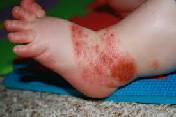
Foot and Mouth Disease (FMD) is a severe, highly contagious viral disease of livestock with signifi cant economic impact. The disease affects cattle and swine as well as sheep, goats, and other cloven-hoofed ruminants. All species of deer and antelope as well as elephant, and giraffe are susceptible to FMD.
In a susceptible population, morbidity approaches 100%. Intensively reared animals are more susceptible to the disease than traditional breeds. The disease is rarely fatal in adult animals but there is often high mortality in young animals due to myocarditis or by lack of milk when the dam is. infected by the disease.
FMD is characterized by fever and blister-like sores on the tongue and lips, in the mouth, on the teats and between the hooves. The disease causes severe production losses and while the majority of affected animals recover, the disease often leaves them weakened and debilitated.
The organism which causes FMD is an aphthovirus of the family Picomavindae. There are seven strains (A, O, C, SAT1, SAT2, SAT3, Asial) each one requiring a specifi c vaccine strain to provide immunity to a vaccinated animal.
FMD is a disease listed in the World Organization for Animal Health (OIE) Terrestrial Animal Health Code and must be reported to the OIE (OIE Terrestrial Animal Health Code). FMD is the ft rst disease for which the OIE established an offi cial list of free countries and zones with or without vaccination.
Member Countries can also ask the OIE to offi daily recognise their national programmes for FMD control.



